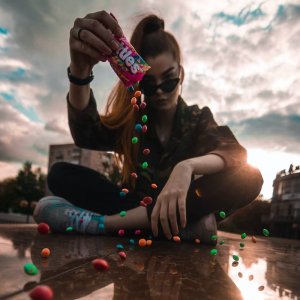Retailers understand the significance of making an emotional connection with their customers, and a great way to do this is through the use of their senses. The limbic system in the brain is responsible for processing emotions, memories, and motivation, and when we experience something through our senses, it can trigger an emotional response.
As online shopping becomes more prevalent, it’s crucial for brands to create a comprehensive sensory experience for their customers. While sight and sound are relatively easy to engage through high-quality images, videos, and background music, the sense of taste, touch, and smell need to be stimulated through written words and descriptive visuals.
Given technology today, the opportunities in sensory UX design exist within digital products and channels themselves.
What is sensory UX
Sensory user experiences are a new approach. They aim to enhance user experience by appealing to each of the senses digitally via use of various sensory stimuli (sight, sound, touch and smell) in UX design to enhance the overall perception and engagement of a product or service.
By creating a holistic, immersive and memorable experience that appeals to all five senses a brand can create an emotional connection that leads to a positive impact on its customer.
For example, seeing a stunning sunset, hearing a nostalgic piece of music, or smelling a familiar fragrance can evoke a strong emotional reaction. This connection between our senses and emotions is why sensory experiences are so powerful and memorable.
Why is sensory UX important?
In UX design, sensory appeal is essential for creating an engaging and memorable user experience. It boosts user engagement and satisfaction by providing users with sensory stimulation beyond the visual and auditory elements. This helps to establish a stronger emotional bond between users and a product, service, or brand.
Better user engagement
When users interact with a product or service through multiple senses, it will greatly increase their level of engagement. When sensory stimulation goes beyond just the visual and auditory elements a user experience will be more immersive and memorable, increasing both engagement and satisfaction.
Triggers emotions
Our senses process emotions, memories, and motivation. When designers create experiences that engage multiple senses, it can trigger strong emotional responses in users, such as excitement, happiness, or nostalgia. However, it’s important to note that the emotional response to sensory experiences can vary from person to person.
5 reasons to prioritise Sensory UX
1. Better user engagement
2. Triggers emotions
3. Build brand recall
4. Competitor differentiation
5. Reach a wider audience
Build brand recall
An experience created through sensory appeal is more likely to be remembered, especially when users associate a positive emotion with said experience. This will lead to increased brand or product recall and recognition.
Competitor differentiation
A unique UX has always been key when it comes to standing out from the competition. By incorporating sensory appeal into your UX design you can differentiate yourself further from your competitors.
Reach a wider audience
Different senses resonate with different people. By incorporating sensory elements, designers can create a more comprehensive user experience that appeals to a wider range of users.
Creating an immersive, multi-sensory user experience online
Creating an immersive, multi-sensory user experience online can be challenging, but there are several strategies that can help. Here are some steps to consider:
1. Identify the senses that you want to engage
Before designing the website, it is important to decide which senses you want to engage and how you want to do it. To do this it is important to identify the sensory stimuli that are most appropriate for a product or service. For example, a wine seller may want to use the sound and image of a cork popping to create a more immersive experience, while a perfume creator might prefer to enhance their user experience with aromas.
2. Use interactive elements
To engage the user’s sense of touch, use buttons or other interactive elements that provide haptic feedback when clicked or tapped. This will allow the user to feel a physical sensation when interacting with the website, making the experience more engaging and immersive.
3. Use high-quality visuals
To engage the user’s sense of sight, use high-quality images and videos that are relevant to the website’s content and purpose. Your visuals may take a step away from your product itself, for example, a photo printer may find it more effective to use videos of people showing positive emotions rather than a simple photo of a print.
4. Use sound effects and background music
To engage the user’s sense of hearing, use background music or sound effects to create a more immersive atmosphere. It is important to consider your user’s context, sound may not be effective if your user is most often in a public place, for example
5. Don’t ignore the power of text
To engage the user’s sense of taste and smell, provide information about food and drink, or about scents that can be experienced through other means.
6. Test and optimise
Through user testing and feedback, as well as iterative design processes you will be able to optimise & improve your user experience appropriately. Especially whilst you try to find the right balance, sensory overload could have a negative effect.
How do we create an effective digital user experience for a product that requires taste, smell or touch?
Online UX affects the perception of products that we taste, touch or smell. And even though our digital lives are devoid of things such as scent or textures, it is still possible to target all the different sensory stimuli to trigger synthetic experiences. Take into consideration the hidden sensory potential of each element: words elicit taste, images evoke odors, sounds stimulate touch.. and so on.
Sight
- Colorful and well contrasted images and videos will evoke emotions, provide visual interest and provide balance.
- A well-designed layout can provide a clear and intuitive navigation experience, helping to improve the overall user experience.
- Motion design is a good path to travel down to animate your product digitally with precision and appropriate effects.
Sound
- Sound effects such as providing feedback when a button is clicked or adding emphasis to certain actions.
- Background will create a more immersive experience by providing an atmosphere or mood.
- Voiceovers can be used to provide additional information or guidance, improving the overall user experience.
Smell
- Use descriptive images and texts to stimulate this sense. Imagination as well as memory will help suggest scents and aromas to your user.
- Actual scent can be added post-purchase, such as scented packaging.
- Encourage your users to describe smell of your product in a review.
- And if your budget allows for it, use a scent technology company to help you incorporate stimuli for this sense in your experience.
Taste
- To engage your user’s sense of taste you can use descriptive videos of someone actually tasting your product.
- Use imagery to present the food or beverage to appeal to the sense of taste
- Describe how the item tastes using words that hook your user’s imagination or memory.
Touch
- Touch can be used to enhance the user experience, such as providing a sense of physical feedback when a button is pressed.
- Use images with textures to describe how a product feels.
- Show a visual of someone touching your product, with a closeup for example.

Technical Limitations
Technical limitations can pose a challenge when incorporating sensory appeal into UX design. For example:
The tools needed to produce AI generated content may not be compatible with your platform
Without the proper technology, the addition of high-quality visuals and graphics may have a negative impact on your web performance
Without an adapted front-end it may near impossible to replicated your sensory experience to different channels, eg. desktop to mobile
A modern e-commerce architecture that is capable of adapting to an innovative UX may be the way to go. Browse the use case below to understand how your e-commerce platform could be the key to implementing the ideal sensory user experience.
Learn more about modern architectures here.
Sensory marketing use case example
Devialet is a French audio technology company that produces high-end speakers and amplifiers for the B2C and BtoB markets.
Devialet’s online e-store reaches customers in 37 different countries. In 2020 they were met with the challenge of needing a better UX, with a custom design that would match the high-end design & powerful sound produced by their products. This user experience also needed to meet today’s standards in terms of performance.
To achieve this Devialet’s e-commerce architecture underwent changes that would then allow them to create the user experience they wanted to bring to their customers, in terms of design and features. They started by taking their existing Magento platform headless, incorporating Front-Commerce as a front-end to boost performance. And then further custom changes were implemented to complete the transformation: special catalogue access for employees, better compatibility with CDNs, memory and resilience optimization.

As you can see from the above video, or from their live website, today’s user experience efficiently portrays the quality of their products’ components and sound, as well as their high-end design, without compromising their web performance, or hindering any future UX innovation or testing. Not to mention, closely followed KPIs that indicate the positive business impact: a 100% lift in conversion rate, a 25% decrease in bounce rate and a Lighthouse performance indicator that increased from 70 to 95.
Read the full use case, including diagrams of their new e-commerce platform architecture, here.
The future of sensory experiences
The latest trends and technologies in a nutshell:
- The use of virtual and augmented reality and virtual reality to create immersive experiences in the consumer space is getting more frequent.
- Digital assistants have matured, and today there is space to go further with voice UI to interact with customers.
- As personalized and experiential marketing drive technical innovation, the services and integrations on the market are improving.
- And whilst it is not yet possible to smell scents via our mobile devices, progress is being made.
Conclusion
Sensory appeal plays a crucial role in the overall user experience (UX) design. By engaging multiple senses, designers can create a more immersive and memorable experience for users, leading to increased customer satisfaction and loyalty.
Incorporating sensory appeal into UX design can greatly enhance the overall user experience and drive growth for your business by triggering emotional responses, increasing brand recall, creating competitive differentiation, and appealing to a wider audience.
